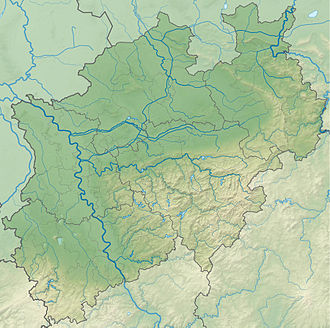Senne (Germany)
 From Wikipedia - Reading time: 7 min
From Wikipedia - Reading time: 7 min
You can help expand this article with text translated from the corresponding article in German. (July 2017) Click [show] for important translation instructions.
|
| Senne | |
|---|---|
 | |
| Map | |
| Geography | |
| Location | Ostwestfalen-Lippe, Nordrhein-Westfalen, Germany |
| Coordinates | 51°51′N 8°47′E / 51.85°N 8.78°E |
| Area | 210 km2 |
| Ecology | |
| Ecosystem(s) | moorland, sand dunes |



The Senne (German pronunciation: [ˈzɛnə] ⓘ) is a natural region in the Regierungsbezirk of Detmold, in the state of Nordrhein-Westfalen in west-central Germany. It lies to the west of the Teutoburger Forest, and has an area of approximately 210 km2.[1] It lies between the cities of Bielefeld to the north-west, Detmold to the north-east, and Paderborn to the south.
Heath, calcareous grassland, and moorland cover most of the area. The river Ems arises here. Flora and fauna are very rich in the Senne, 901 of the 5000 animal and plant species are listed on the IUCN Red List.[2]
116 km2 of the Senne and therefore more than the half of it area are taken by the Sennelager Training Area, which is mainly used by British forces. By 2020 all of the planned reductions in British forces had been completed,[3] which now leaves the future of this landscape undecided.
Fauna
[edit]The region is the home of a critically-endangered breed of riding horse, the Senner, which is believed to be the oldest breed of riding horse in Germany, and is documented at least as far back as 1160.[4][5] It lived in feral herds in the moorlands and in the Teutoburger Forest to the east. In 1999, some were introduced to the Moosheide nature reserve to assist in conservation grazing.[6]: 502
References
[edit]- ^ 54006 Senne (in German). Bundesamt für Naturschutz. Accessed July 2017.
- ^ "BUND NRW zum Entstehen des Nationalparks Senne". Archived from the original on 5 September 2016.
- ^ "Britische Soldaten sollen bis 2020 abziehen". www.immobilien-zeitung.de (in German). Retrieved 7 December 2020.
- ^ Senner (in German). Gesellschaft zur Erhaltung alter und gefährdeter Haustierrassen. Accessed July 2017.
- ^ Mathias Vogt (1995). Schwerpunkt – Pferde: Der Senner – die älteste Reitpferdezucht in Deutschland (in German). Gesellschaft zur Erhaltung alter und gefährdeter Haustierrassen. Accessed July 2017.
- ^ Valerie Porter, Lawrence Alderson, Stephen J. G. Hall, D. Phillip Sponenberg (2016). Mason's World Encyclopedia of Livestock Breeds and Breeding (sixth edition). Wallingford: CABI. ISBN 9781780647944.
 KSF
KSF